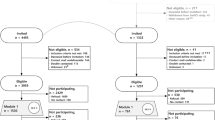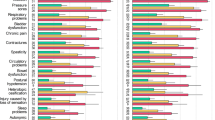Abstract
Study design
Cross-sectional survey.
Objectives
To evaluate the annual influenza vaccination coverage rate (IVCR) among community-dwelling individuals with spinal cord injury (SCI).
Setting
SCI community in Switzerland.
Methods
Participants were responders to the influenza vaccination question (n = 492) in the 2012 community survey of the Swiss Spinal Cord Injury (SwiSCI) cohort study. IVCR of SwiSCI participants were compared to the normative Swiss population, sampled in the Swiss Health Survey of 2012 using direct standardization, logistic regression standardization, and a genetic matching approach to control for differences in age, sex, and quarterly period of survey response.
Results
Individuals with SCI showed higher crude (26%, 95% confidence interval (CI): 22–30%) and age- and sex-standardized (24%, CI: 23–24%) IVCR than observed in the general population (15% CI, 14–15%). The adjustment for age and sex as well as quarterly period of survey response showed that the standardized IVCR of individuals with SCI (17%; CI: 12–23%) approached that of the general population. Low IVCR of about 10% were found among individuals with SCI younger than 45 years. IVCR were similar between men and women and between individuals with incomplete and complete paraplegia and tetraplegia.
Conclusion
The IVCR in individuals with chronic SCI was not higher than in the general population and much lower than guidelines recommend. The improvement of the IVCR is an important target of health policy in SCI in Switzerland as to reduce the evidenced excess burden in respiratory-disease related morbidity and mortality.
Similar content being viewed by others
Log in or create a free account to read this content
Gain free access to this article, as well as selected content from this journal and more on nature.com
or
Data archiving
The datasets generated and/or analyzed during the current study are available from the corresponding author on reasonable request.
References
Frankel HL, Coll JR, Charlifue SW, Whiteneck GG, Gardner BP, Jamous MA, et al. Long-term survival in spinal cord injury: a 50 year investigation. Spinal Cord. 1998;36:266–74.
Leite VF, Souza DR de, Imamura M, Battistella LR. Post-discharge mortality in patients with traumatic spinal cord injury in a Brazilian hospital: a retrospective cohort. Spinal Cord. 2018. https://doi.org/10.1038/s41393-018-0183-y.
Chamberlain JD, Meier S, Mader L, von Groote PM, Brinkhof MWG. Mortality and longevity after a spinal cord injury: systematic review and meta-analysis. Neuroepidemiology. 2015;44:182–98.
DeVivo MJ, Black KJ, Stover SL. Causes of death during the first 12 years after spinal cord injury. Arch Phys Med Rehabil. 1993;74:248–54.
Chamberlain JD, Buzzell A, Gmünder HP, Hug K, Jordan X, Moser A, et al. Comparison of all-cause and cause-specific mortality of persons with traumatic spinal cord injuries to the general Swiss population: results from a national cohort study. Neuroepidemiology. 2019;52:205–13.
Whiteneck GG, Jawad MH, Charlifue SW, Charlifue S. Aging with spinal cord injury. New York: Demos Medical Publishing; 1993.
Restivo V, Costantino C, Bono S, Maniglia M, Marchese V, Ventura G, et al. Influenza vaccine effectiveness among high-risk groups: a systematic literature review and meta-analysis of case-control and cohort studies. Hum Vaccin Immunother. 2018;14:724–35.
Osterholm MT, Kelley NS, Sommer A, Belongia EA. Efficacy and effectiveness of influenza vaccines: a systematic review and meta-analysis. Lancet Infect Dis. 2012;12:36–44.
Ahmed AH, Nicholson KG, Nguyen-Van-Tam JS. Reduction in mortality associated with influenza vaccine during 1989-90 epidemic. Lancet. 1995;346:591–5.
Trautner BW, Atmar RL, Hulstrom A, Darouiche RO. Inactivated influenza vaccination for people with spinal cord injury. Arch Phys Med Rehabil. 2004;85:1886–9.
Nokleby H, Nicoll A. Risk groups and other target groups—Preliminary ECDC guidance for developing influenza vaccination recommendations for the season 2010-11. Eur Surveill. 2010;15:1–4.
Grohskopf LA, Sokolow LZ, Broder KR, Walter EB, Fry AM, Jernigan DB. Prevention and control of seasonal influenza with vaccines: recommendations of the Advisory Committee on Immunization Practices—United States, 2018–19 influenza season. MMWR Recomm Rep. 2018;67:1–20.
Federal Office of Public Health. Seasonal flu (influenza). 2018. https://www.bag.admin.ch/bag/en/home/krankheiten/krankheiten-im-ueberblick/grippe.html.
Budd A, Blanton L, Grohskopf L, Campbell A, Dugan V, David; et al. Surveillance Manual—Chapter 6: Influenza. https://www.cdc.gov/vaccines/pubs/surv-manual/chpt06-influenza.pdf. Accessed 27 Feb 2019.
Spreyermann R, Lüthi HJ, Michel F, Baumberger M, Curt A, Wirz M, et al. Vorsorge und Nachsorge II, Gesundheitscoaching bei querschnittgelähmten Patientinnen und Patienten. Ludwig‐guttmann‐pr der DMGP; 2013.
Hosack K. Spinal cord injury re-evaluations and follow-up care made in initial rehabilitation. Englewood, Colorado 2014. https://craighospital.org/uploads/CraigHospital.ReevaluationWhitepaper_2014.pdf. Accessed 20 Mar 2019.
Cosortium for Spinal Cord Medicine. Respiratory management following spinal cord injury: a clinical practice guideline for health-care professionals. J Spinal Cord Med. 2005;28:259–93.
Brinkhof MWG, Fekete C, Chamberlain JD, Post MWM, Gemperli A. Swiss national community survey of functioning after spinal cord injury: protocol, characteristics of participants and determinants of non-response. J Rehabil Med. 2016;48:120–30.
Fekete C, Segerer W, Gemperli A, Brinkhof MWG. Participation rates, response bias and response behaviours in the community survey of the Swiss Spinal Cord Injury Cohort Study (SwiSCI). Bmc Med Res Methodol. 2015;15:80.
Biering-Sørensen F, DeVivo MJ, Charlifue S, Chen Y, New PW, Noonan V, et al. International spinal cord injury core data set (version 2.0)—including standardization of reporting. Spinal Cord. 2017;55:759–64.
Swiss Federal Office of Statistics. Swiss Health Survey 2012. Berne: Swiss Federal Office of Statistics; 2013.
Zürcher K, Zwahlen M, Berlin C, Egger M, Fenner L, Berlin C et al. Trends in influenza vaccination uptake in Switzerland: Swiss Health Survey 2007 and 2012. Swiss Med Wkly. 2019;149: 4–11.
Sjölander A. Regression standardization with the R package stdReg. Eur J Epidemiol. 2016;31:563–74.
Sekhon JS. Multivariate and propensity score matching software with automated balance optimization: the matching package for R. Social Science Research Network: Rochester, NY; 2008.
Weaver FM, Smith B, LaVela S, Wallace C, Evans CT, Hammond M, et al. Interventions to increase influenza vaccination rates in veterans with spinal cord injuries and disorders. J Spinal Cord Med. 2007;30:10–19.
Goldstein B, Miskevics S, Etingen B, LaVela S, Weaver F, Goldstein B, et al. Factors associated with H1N1 influenza vaccine receipt in a high-risk population during the 2009–2010 H1N1 influenza pandemic. Top Spinal Cord Inj Rehabil 2012;18:306–14.
Lofters A, Chaudhry M, Slater M, Schuler A, Milligan J, Lee J et al. Preventive care among primary care patients living with spinal cord injury. J Spinal Cord Med. 2018. https://doi.org/10.1080/10790268.2018.1432308 [Epub ahead of print].
Ronca E, Scheel-Sailer A, Koch HG, Gemperli A. Health care utilization in persons with spinal cord injury: Part 2 - determinants, geographic variation and comparison with the general population. Spinal Cord. 2017. https://doi.org/10.1038/sc.2017.38.
St. Andre J, Smith B, Stroupe K, Burns S, Evans C, Ripley D, et al. A comparison of costs and health care utilization for veterans with traumatic and nontraumatic spinal cord injury. Top Spinal Cord Inj Rehabil. 2011;16:27–42.
Ronca E, Scheel-Sailer A, Koch HG, Metzger S, Gemperli A. Inpatient migration patterns in persons with spinal cord injury: A registry study with hospital discharge data. SSM Popul Heal. 2016. https://doi.org/10.1016/j.ssmph.2016.04.004.
Swiss Federal Office of Statistics. Seasonal influenza reports. https://www.sentinella.ch/de/publications/. Accessed 19 Mar 2019.
Acknowledgements
We are grateful to all the participants of the SwiSCI and SHS surveys for their time and effort spent in responding to the questions. This study has been financed in the framework of the SwiSCI study, supported by the Swiss Paraplegic Foundation.
Members of the SwiSCI Steering Committee
Xavier Jordan4, Bertrand Léger4, Michael Baumberger5, Hans Peter Gmünder5, Armin Curt6, Martin Schubert6, Margret Hund-Georgiadis7, Kerstin Hug7, Thomas Troger8, Daniel Joggi9, Hardy Landolt10, Nadja Münzel11, Mirjam Brach1, Gerold Stucki1, Christine Fekete12,
Funding
All authors were salaried by organizations financially compensated by the Swiss Paraplegic Foundation.
Author information
Authors and Affiliations
Consortia
Contributions
ER and MM were responsible for data analysis. ER and MB were responsible for research design. ER, MM, and MB were responsible for introduction, methods, results, discussion, and conclusion sections.
Corresponding author
Ethics declarations
Statement of ethics
We certify that all applicable institutional and governmental regulations concerning the ethical use of human volunteers were followed during the course of this research. All SwiSCI participants signed a written consent form before completing the survey. The study was approved by the ethics committee of northwest/central Switzerland. Data of the SHS were anonymized before analysis. The permission to analyze and publish the data was obtained through a contract with the Swiss Federal Office of Statistics.
Conflict of interest
The authors declare that they have no conflict of interest.
Additional information
Publisher’s note: Springer Nature remains neutral with regard to jurisdictional claims in published maps and institutional affiliations.
Supplementary information
Rights and permissions
About this article
Cite this article
Ronca, E., Miller, M., Brinkhof, M.W.G. et al. Poor adherence to influenza vaccination guidelines in spinal cord injury: results from a community-based survey in Switzerland. Spinal Cord 58, 18–24 (2020). https://doi.org/10.1038/s41393-019-0333-x
Received:
Revised:
Accepted:
Published:
Issue date:
DOI: https://doi.org/10.1038/s41393-019-0333-x



